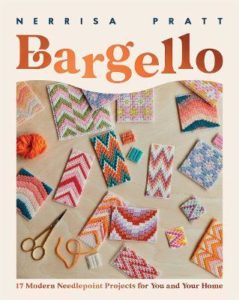Nerrisa Pratt,,Quadrille, 2021, ISBN978-1-78713-725-7, $22.99

Bargello seems to have taken the needlework world by storm. There are new books about the technique, this is one, new companies such as Hello Bargello, and other designers venturing into these patterns from designers and others. This is not exactly the Bargello of a few years ago. It uses large-mesh canvas, tapestry wool, and relatively simple patterns.
You shouldn’t be surprised by this popularity. Bargello is incredibly easy to learn, you can put the instructions on a postcard and teach it in minutes. You can use easily available materials, and you don’t need to buy expensive painted canvases to create beautiful items. It’s colorful and cheerful and you get results very quickly.
The book is designed for beginners with about 25% of the book taken up with reference information. While much of the information is good, all too often it shows a slap-dash attitude that doesn’t help beginners. For example, there is a page defining several basic patterns. While the definitions are correct the full-page picture of samples next to them shows two of the seven patterns and one of those is shown twice. If Pratt makes a big deal out of swatching patterns why doesn’t she have swatches of the other five patterns?
Unhappily this is just the first instance of missing photos. Techniques may or may not have photos illustrating them and the text never tells you where to find what photos there are. I found myself asking if it was too much trouble to add “next page” to the text.
When she gets to suggesting pairs of ground and thread here combinations may cause major problems if you try to use them. This is particularly true for her plastic canvas suggestions. (I should note that plastic canvas is commonly used in these newer Bargello projects, along with knitting yarns0. Pratt suggests using chunky-weight knitting yarn with 10-count plastic and super-chunky yarn with 7-count. Bith of these yarns are far too heavy for these grounds.10-count plastic canvas takes worsted yarn, which is the same thickness as tapestry wool.
Following this section are the 17 projects. While mostly for the home, accessories and clothing items are also included. Each project has a skill level, a materials list and the amount of time it takes to complete. Illustrations of the completed project, some stitching pictures and a color chart of the pattern illustrate each project. The text for the project has instructions, including ones for making the project.
Some of the projects require sewing skills, including sewing leather, others need already-made items including furniture, lampshades, shirts, and shoes, In two cases, the upcycled shirt and the trainers (sneakers) I’m not entirely sure her method would work. In another case, her suggestion of using tapestry wool to embellish something that could be washed will lead to unhappy results.
The book finishes with a nice summary of the materials used in each project, along with some UK-based suppliers. While I wish the US was not ignored this is a British book by a British author, published by a UK publisher.
Overall while many of the projects are original, I’m not happy with the book or its approach. Overall it smacks too much of a 1970’s “hand-made at home” ethic. When crafting was a really big thing in my youth, there was lots of this quick, slap-dash stuff going around. It is at least partly my upbringing but with a mother who was an artist and a grandmother who was an amazing professional seamstress, this ethic was not a part of our lives. Yes, you ould be bad at something or you could be making mistakes, but you always took the art seriously, and strove for good-looking results. It doesn’t mean you have no fun. It doesn’t mean you don’t make things quick and easy. But it does mean that you look to do it right. That you find ways to make things easier for the beginner. I wish that was more present in this book.
I think that if you want to introduce Bargello to Millenials and younger stitchers, this is a good reference. Give them this book and some good matrials, show them how to start and you’ll have the makings of a good stitcher. Otherwise, give it a pass, you can do better yourself,
About Janet M Perry
Janet Perry is the Internet's leading authority on needlepoint. She designs, teaches and writes, getting raves from her fans for her innovative techniques, extensive knowledge and generous teaching style. A leading writer of stitch guides, she blogs here and lives on an island in the northeast corner of the SF Bay with her family

Leave a Reply